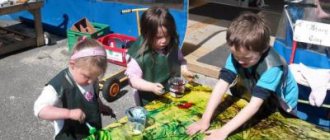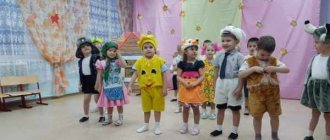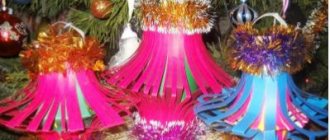Summary of an open lesson for the senior group in mathematics “Travels through fairy tales”
Nina Doronina
Summary of an open lesson for the senior group in mathematics “Travels through fairy tales”
Goal: to systematize children's mathematical concepts ; bring children joy from educational games; maintain interest in fairy tales .
Learn to count within 10; learn to name the previous and subsequent ones and correlate the number of objects with the number;
Continue to learn to determine the location of an object and designate it with words: left, right, middle, top bottom.
Improve the ability to distinguish and name geometric shapes: circle, square, rectangle, triangle.)
develop logical thinking, memory, attention, observation, develop coherent speech, enrich children's vocabulary
Material for the lesson:
Demonstration - magnetic board, images of cartoon characters from different fairy tales , counting sticks.
Handout - simple pencils, a set of numbers up to 10, fairy-tale characters with a task , a chamomile, a Christmas tree, a butterfly, a mushroom, a leaf.
Methodological techniques: game situation, conversation-dialogue, looking at pictures, productive activity of children, analysis.
Preliminary work; Mathematics classes , didactic games with numbers, reading fairy tales , looking at illustrations based on fairy tales , independent activities with mathematical material , with geometric figures, individual work.
Methods and techniques: Literary word, riddles, encouragement, characters from fairy tales , questions.
Extracurricular activity "Journey to the land of fairy tales"
3 testName the fairy tale based on the illustration
SL (No. 3,4,5,6,7,8,9)
(Geese-swans, a fairy tale about a fisherman and a fish, the snow queen, little red riding hood, puss in boots, a traveler frog, a silver hoof)
4 test
Let's draw our fairy-tale hero and come up with a name for him.
And now you and your desk neighbor must come up with a fairy tale with the participation of your heroes according to the plan that you see on the board. SL10
1.Introduction
2.Description of the heroes (appearance, character) 3.Development of actions - plot (the actions of the heroes and the reasons for these actions) 4.Climax (the most intense moment in the fairy tale)
Physical exercise based on the fairy tale turnip
Grandfather planted a turnip in the garden (sit down)
And he poured water from a watering can on the turnip (we quietly rise)
Grow, grow, turnip, both sweet and strong (we stretch up on our toes)
The turnip grew to everyone's surprise (they raised their shoulders)
Big, big for everyone - enough treats (arms to the sides)
5 test
Guess the hero your card is about and tell everything you know about him
Pinocchio is a wooden doll, planed by Papa Carlo from a log. He is stupid and naive. Pinocchio deceives dad Carlo and instead of going to school he goes to the street theater led by Karabas Barabas. Then Pinocchio falls for the trick of the cat Basilio and the fox Alice and actually gives them the money that was intended to buy the alphabet. Only after meeting the old and wise turtle Tortilla, Pinocchio changes. Yes, anyone would change if they heard in your address that you are a brainless boy with short thoughts, and also gullible. After such words, Pinocchio becomes smarter, more careful, but remains just as cheerful and mischievous. He manages to cope with Karabas Barabas and find out from him the secret of the golden key. It turns out that this key opens the door located in Papa Carlo’s closet and leads to the theater where Pinocchio remains to live. He really likes it there, he takes part in the performances, joy, happiness, laughter and fun reign in this open world of Baratino..
Aibolit is the hero of the fairy tale in verse “Aibolit” (1929) and the prose work “Doctor Aibolit (according to Hugh Lofting)” by K.I. Chukovsky. The patient’s alarmed cry “Ay! Hurts!" turned into the most affectionate name in the world. A. is a fabulous doctor, very kind, because he treats with chocolate and eggnog. He rushes to the rescue through snow and hail, overcomes steep mountains and raging seas, saying only one thing: “Oh, if I don’t get there, // If I disappear along the way, // What will happen to them, to the sick, // To my animals forest?" Doctor A. from the prose fairy tale is the very embodiment of kindness and sweet adventurism: he selflessly fights the bloodthirsty Barmaley, frees the boy Penta and his fisherman father from pirate captivity, and is not afraid to protect the poor and sick monkey Chichi from the terrible organ grinder. For this, A. is loved by all animals, fish and birds, boys and girls. Chukovsky teaches little readers about justice and respect for people and animals, talking about the good deeds of Doctor A. and his faithful friends.
Cinderella - In fairy tales, all the heroes are different, but my favorite hero is Cinderella. She is very beautiful, attractive, slim, kind. She always helped her stepmother and her sisters. She married a good prince charming. The character “Cinderella” can only be described in good words, since the hero is very good.
Malvina-Malvina-doll, with blue curly hair, head made of porcelain, body stuffed with cotton wool, eyes wide. Malvina escaped from the Karabas-Barabas theater, settled in a secluded house in a gray clearing with her dog friend Artemon. House, furniture, doll-sized dishes Malvina’s character is very interesting. Malvina is kind (animals, insects, birds love her), hardworking, smart (teaches B arithmetic, write from dictation), takes care of her appearance (powders herself with pollen, her face is freshly washed), neat (adjusts folds in her dress and bows).A.N. Toltoy has a positive attitude towards M., because she has a lot of positive traits. I completely agree with him.
Open lesson in mathematics “Journey to a Fairy Tale” in the senior group
Zhanna Lychagina
Open lesson in mathematics “Journey to a Fairy Tale” in the senior group
Topic: Journey into a fairy tale .
• Continue to teach children how to measure the length of an object (using a conventional measure)
;
• Strengthen quantitative and ordinal counting, knowledge of geometric shapes and identifying them by size, color and shape;
• To develop design skills according to a given pattern, the ability to navigate in space;
• Develop memory, imagination, logical thinking;
• Activate children's speech with special terms, expand their active vocabulary;
• Cultivate responsiveness, a sense of empathy, and a desire to help fairy-tale characters .
Equipment and material : two tracks (straight and wavy)
;
umbrella with geometric shapes; subject pictures according to the number of children; figures for the number of children; characters from the fairy tale “Teremok”
; letter from Mishka; game visualizers and markers for each child; paper napkins; Cuisenaire rods; house plans; present.




